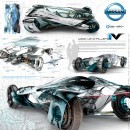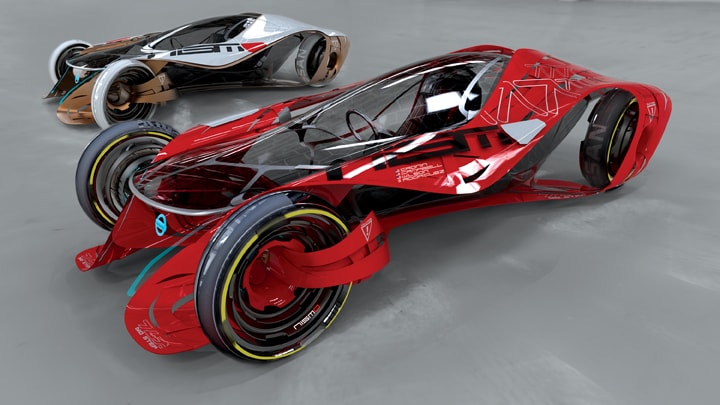As you know, the 2010 Los Angeles Auto Show also includes the LA Design Challenge, a competition that has asked automotive producers from around the world to create eco-conscious vehicles with a top design that weigh less than 1,000 pounds (454 kg).
Now, we are here to see what Nissan has prepared for the contest. Dubbed IV, the concept you see here is inspired by nature and human ingenuity. We are talking about a feather-light sports tourer and uses parts that are cultivated in a 100 percent sustainable, carbon-neutral process, with the fabrication technology using the “organic synthetics” name.
The vehicle uses an interwoven organic frame, that is built from a biopolymer frame which mixes fast-growing ivy and re-enforced with spider silk composite. This allows the frame to be flexible and light, yet ultra-strong.
The concept’s panoramic cabin can accommodate four adults and uses a photovoltaic material that weighs 99 percent less than conventional glass. The canopy collects solar energy which is used as extra juice for the vehicle’s systems. However, the main power source is a slim bio-battery. The vehicle also comes with a regenerative super-capacitor technology that recuperated 60 percent of the kinetic energy spent.
Now that we’ve talked about energy, we must tell you that the vehicle is powered by concentric hub-less in-wheel electric motors, which also acts as a suspension and steering, using magnetic levitation and propulsion.
“Concentric magnetic rings amplify rotation with each outer ring to boost high-speed performance and provide independent wheel control for ultimate handling and maneuverability. Inspired by schools of fish and their fluid movement, Nissan’s pro-active Safety Shield renders collisions a thing of the past and reduces weight by eliminating the need for heavy structures (bumpers, beams, airbags, etc.),” explained the press release.
Now, we are here to see what Nissan has prepared for the contest. Dubbed IV, the concept you see here is inspired by nature and human ingenuity. We are talking about a feather-light sports tourer and uses parts that are cultivated in a 100 percent sustainable, carbon-neutral process, with the fabrication technology using the “organic synthetics” name.
The vehicle uses an interwoven organic frame, that is built from a biopolymer frame which mixes fast-growing ivy and re-enforced with spider silk composite. This allows the frame to be flexible and light, yet ultra-strong.
The concept’s panoramic cabin can accommodate four adults and uses a photovoltaic material that weighs 99 percent less than conventional glass. The canopy collects solar energy which is used as extra juice for the vehicle’s systems. However, the main power source is a slim bio-battery. The vehicle also comes with a regenerative super-capacitor technology that recuperated 60 percent of the kinetic energy spent.
Now that we’ve talked about energy, we must tell you that the vehicle is powered by concentric hub-less in-wheel electric motors, which also acts as a suspension and steering, using magnetic levitation and propulsion.
“Concentric magnetic rings amplify rotation with each outer ring to boost high-speed performance and provide independent wheel control for ultimate handling and maneuverability. Inspired by schools of fish and their fluid movement, Nissan’s pro-active Safety Shield renders collisions a thing of the past and reduces weight by eliminating the need for heavy structures (bumpers, beams, airbags, etc.),” explained the press release.











